Living in a time where remote working is not only a perk but an essential part of safe and effective business, companies are forced to rethink the way they operate.
The question of whether freelancing is just a fad is no longer relevant – it’s here, and work flexibility is now a serious consideration for organizations and individuals alike. The real question is: can you actually make a decent living doing it? And is hiring a freelancer for your project a good investment?
Vague reassurances and promises aren’t enough. You need hard data and reliable information before making an investment or changing the course of your career.
Don’t worry – we’ve got your back.
We’ve combed through the most recent reports and studies and have pulled together a ton of information that proves freelancing is something that everyone should be taking seriously, whether you’re looking for work or looking to hire.
But don’t take our word for it. The numbers speak for themselves.
Freelancing in the Shadow of a Pandemic
At the mercy of a virus that’s caused a global pandemic, the freelance market in many countries is already changing significantly. For some, the uncertainty weighs heavily upon the economy, forcing difficult decisions. For others, a restructuring is taking form, and the dependency on flexible working is a forced reality rather than a considered choice.
1. Short-Term Demand Falls, but Not All Hope is Lost
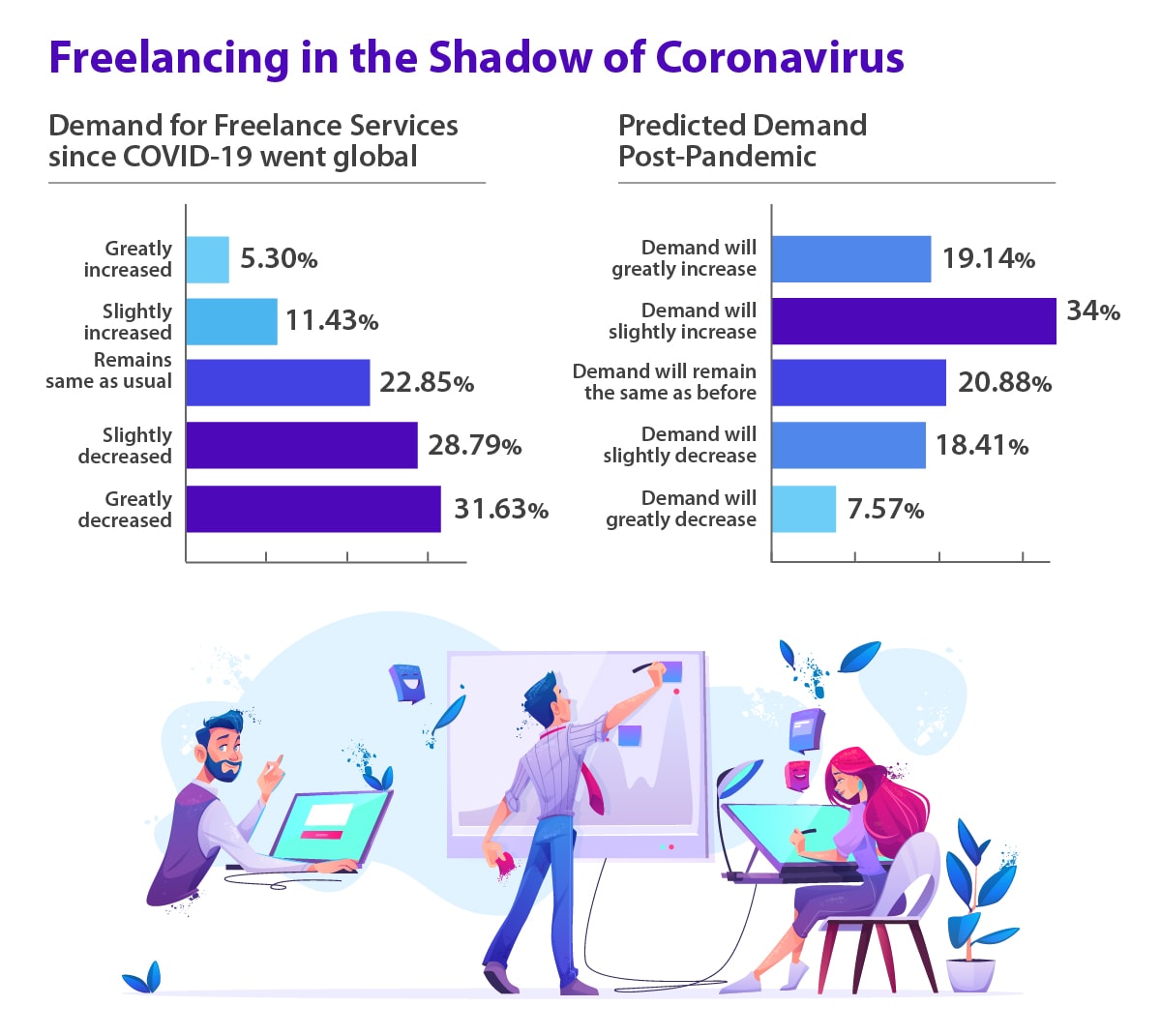
More than half of global freelancers (60%) reported a decrease in demand for their services in the past three months. However, nearly 17% of freelancers reported the opposite.
Nonetheless, most freelancers (74%) are still optimistic about the future, with more than half (53%) expecting to see an uptick in the long run. This is due to the increase in off-site work, which could provide more freelance opportunities as teams move to remote operations.
For small and medium-sized businesses (SMBs), this situation is a win-win, as they reduce their overheads (workspace, benefits) and increase their talent pool by removing traditional geo-restrictions and bureaucratic boundaries.
2. The Impact of a Pandemic on Freelancers in Europe
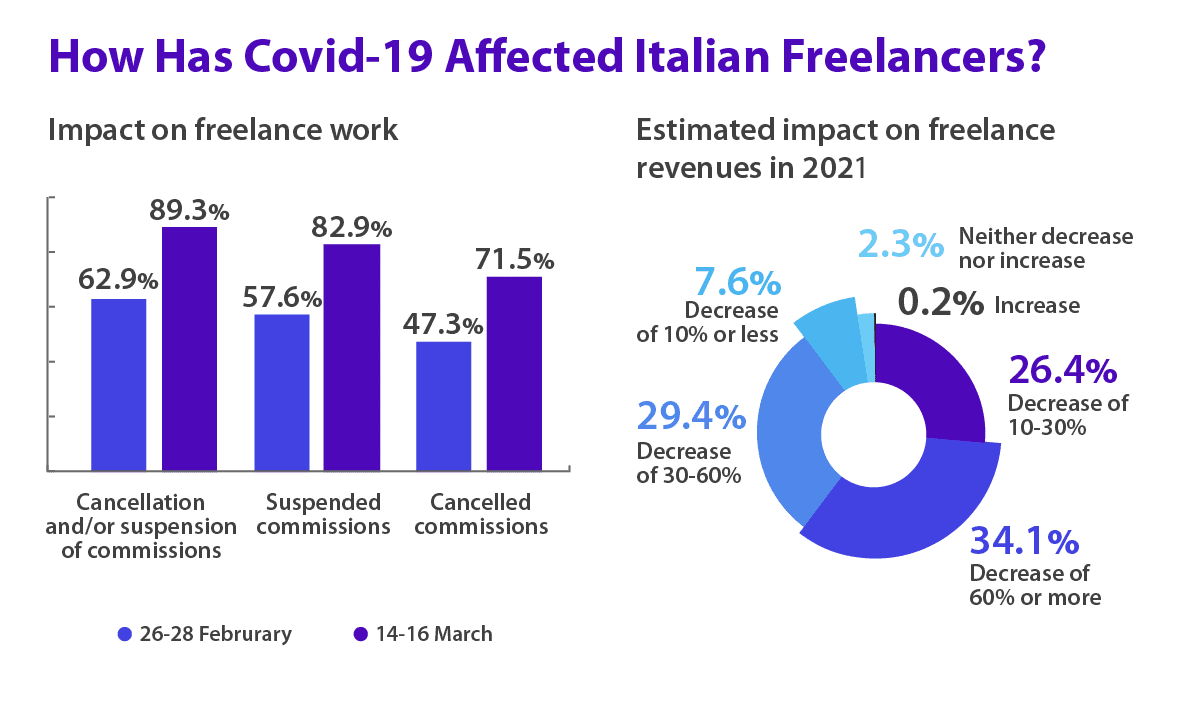 Freelancers in Italy have had a tough time of it, with nearly nine out of ten reporting canceled or suspended contracts and more than half indicating a decrease of up to 60% of their typical freelance-earned revenue.
Freelancers in Italy have had a tough time of it, with nearly nine out of ten reporting canceled or suspended contracts and more than half indicating a decrease of up to 60% of their typical freelance-earned revenue.
In France, optimistic self-employed people outweigh those with a more pessimistic outlook. Still, nearly one-third (32%) considered the idea of compulsory liquidation (similar to bankruptcy in the US) stating they would probably or most certainly make such a move.
3. Freelancers and Economic Instability
As a whole, freelancers find having multiple sources of income allows them better financial security, with 65% agreeing that “having a diversified portfolio of income from multiple clients is more secure than having one employer.”
They’re also happy to take on more work, with 93% of full-time freelancers agreeing that, “If I ever need to, I can work more to earn more money.”
Non-freelancers are also tempted by this reasoning, as 76% said they would consider freelancing in a time of recession.
The Current Freelance Job Market
Let’s take a look at the available opportunities, the most popular jobs, and the skills you need to win them.
4. The Number of Freelancers Is Growing—Fast
- 41% of the American workforce freelanced in 2020, up 13% since 2013
- At the same time, non-freelancers only grew by 2%
- 28% of Americans freelance full-time, up 17% from 2014
- 53% of Generation Z (18-22) chooses the freelancing route
This growth is mainly driven by younger generations, with 53% of working Generation Zers currently freelancing – more than any other generation. And at the same time, more Millennials are freelancing full-time (40%), suggesting it’s becoming a lifestyle choice rather than just a financial supplement.
5. How Freelancers Look for Work
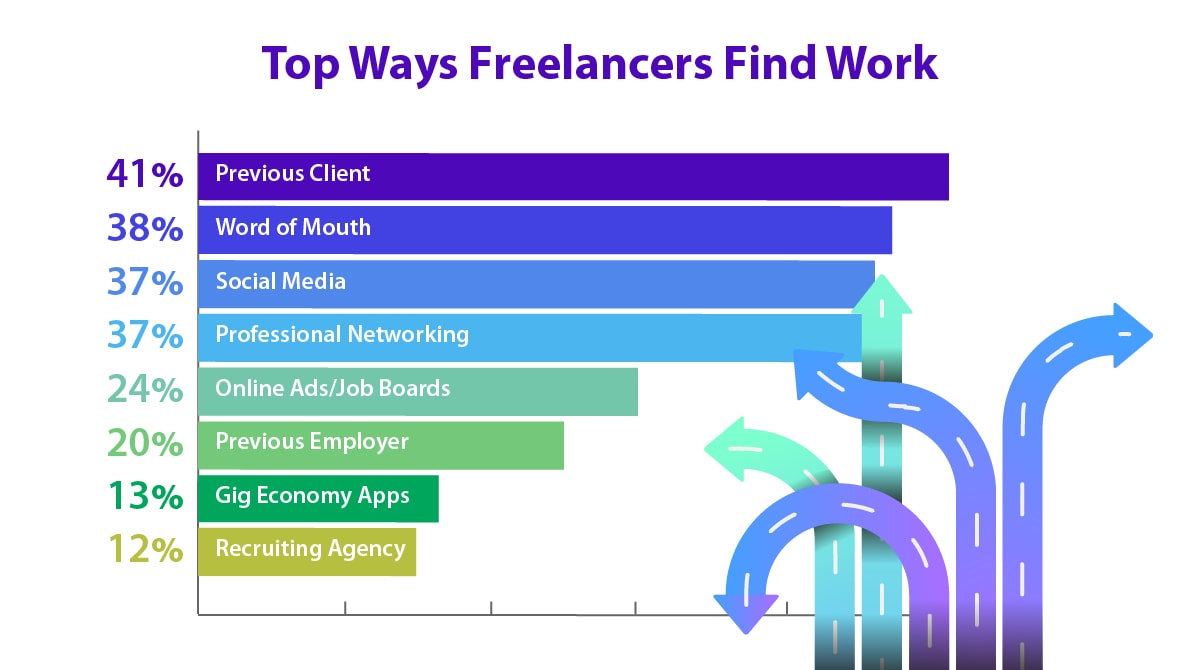
We investigated where most freelancers look for work and made an interesting discovery. Most freelancers depend on their connections and networking to find new clients.
Other popular methods include recruitment firms, online job boards, and gig-economy apps. If you’re just starting out, it’s best to try a number of methods to see what works best for you.
6. The Largest Freelance Platforms
These are the largest freelance websites by the number of users (clients and freelancers):
The largest freelance platform by the number of users is Freelancer.com, with more than 31 million. You can read our review to find out what it’s like to work on the platform.
The second most populous, but considered the best by many freelancers, is Upwork, with more than 17 million registered users (12 million freelancers, five million clients). Curious what it’s like to work as a freelancer on Upwork? Take a look at our review.
You can also learn about what it’s like to work on the third-largest platform, Fiverr, by reading our review. Whether you’re looking to work or hire, freelancing platforms are definitely a strategy to consider.
7. Where Clients Are Located
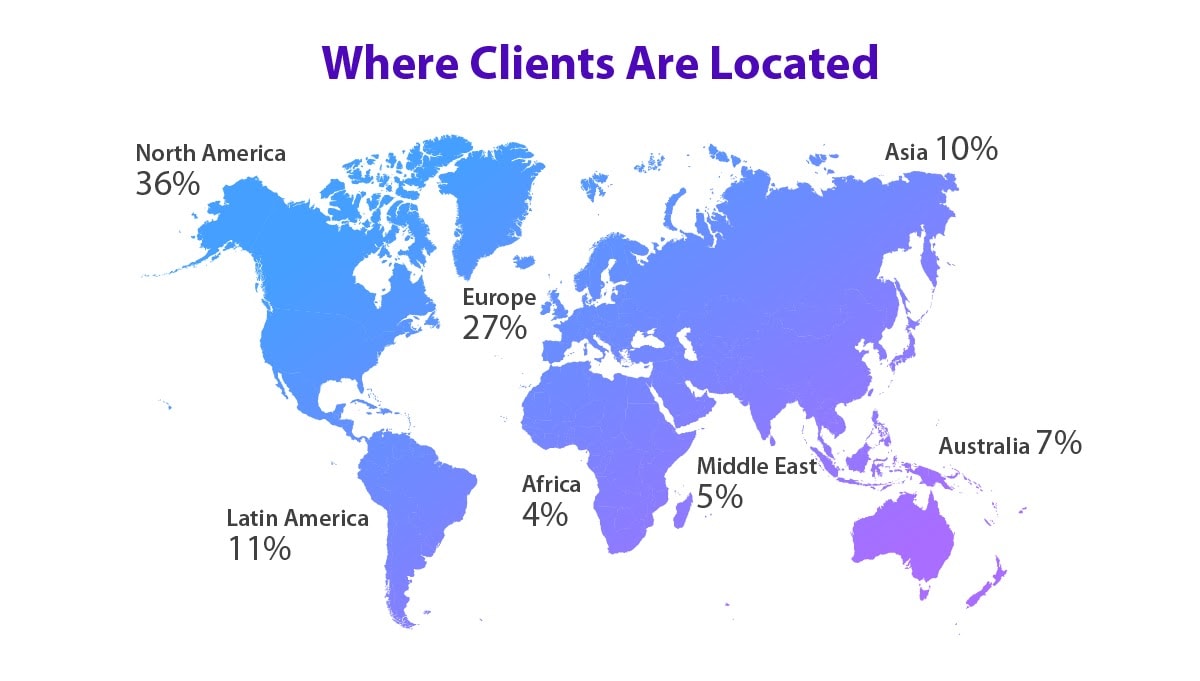 Financial services company, Payoneer, recently asked freelancers where their clients were located. The majority were in North America (36%), while clients in Europe made up 27%. The regions with the fewest clients were Australia (7%), the Middle East (5%), and Africa (4%).
Financial services company, Payoneer, recently asked freelancers where their clients were located. The majority were in North America (36%), while clients in Europe made up 27%. The regions with the fewest clients were Australia (7%), the Middle East (5%), and Africa (4%).
While remote working eliminates geography as a barrier to work, freelancers should keep in mind that the level of pay is often in line with the cost of living in the client’s country.
8. Top Time Commitments for Freelance Positions
Average hours worked per week by job type:
- Management and human relations: 39 hours
- Engineering and manufacturing: 38.2 hours
- Customer support and administrative positions: 38.2 hours
- Programming and IT: 37.4 hours
- Marketing and sales: 37 hours
- Multimedia and design: 36.5 hours
- Translators and writers: 34 hours
- Legal positions: 33.6 hours
The number of hours worked per week varies greatly based on a freelancer’s area of expertise and the nature of the work (e.g., accountants are busiest over tax season). However, most freelancers work comparable hours to full-time, salaried employees.
While many freelancers choose to work part-time, some positions require a full-time commitment. Positions requiring the most hours include management (39 hours per week, on average), as well as engineering, manufacturing, customer support, and administrative positions (38.2 hours).
9. Freelancers Turn to Training for Career Advancement
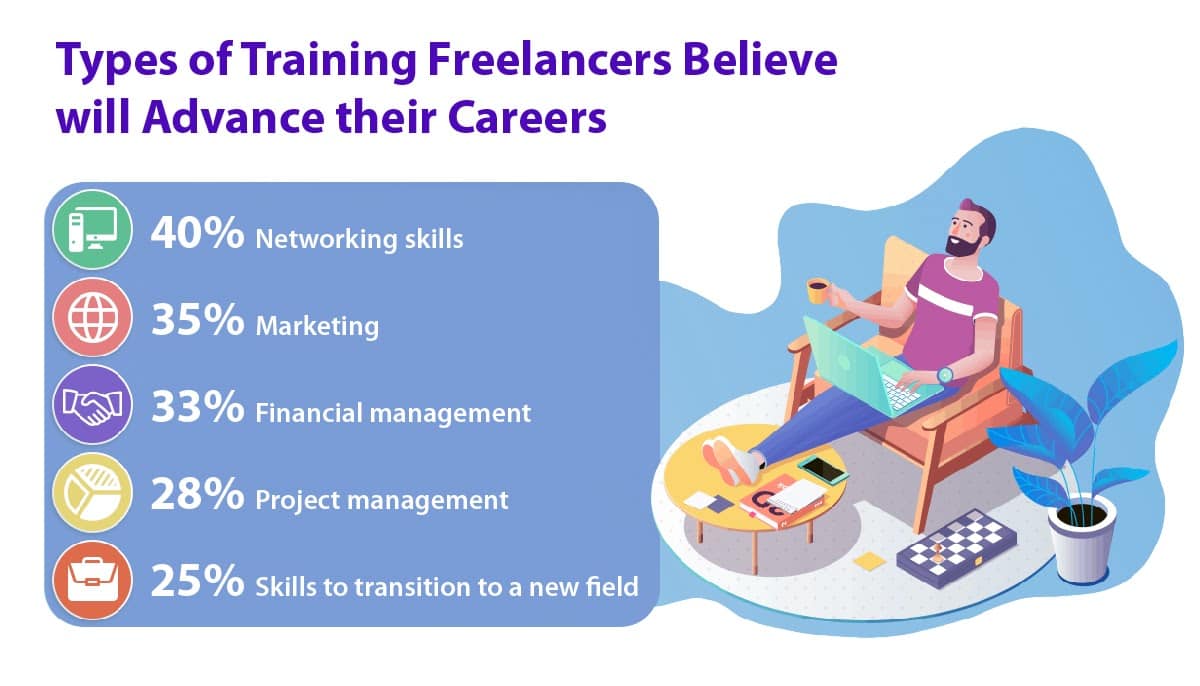
A recent study asked freelancers what skills they’re most interested in improving to advance their careers. Given the nature of the freelance economy, it’s not surprising that the highest percentage (40%) hoped to improve their networking skills.
Marketing skills are the second most coveted at 35%. Other desirable skills include financial management (33%), project management (28%), and skills to transition to a new field (25%).
This points to a demand for upskilling within the freelance community, which could be met through apps or training programs.
10. Businesses and Individuals Are Embracing Remote Work
Of all the organizations around the world (with a staff of 1,000+), a fifth include at least 30% remote workers. And during the last five years, 50% of all organizations had a substantial increase in their freelance workforce.
Up to 50% of jobs within the U.S. are compatible with remote work and 80% of workers say they’d like to work remotely, on a part-time basis, at least. However, only 7% of businesses actually allow for employees to work remotely on any level.
That said, there are quite a few large businesses that have begun to use a completely remote staff. These include Edgar, Toptal, Basecamp, InVision, Ghost, Automattic, Zapier, Hubstaff, Trello, Buffer, Groove, Doist, and Toggl. This shows that businesses and individuals alike are becoming more comfortable with remote working.
The Freelance Workforce
The following stats focus on freelancers themselves, including info about their interests, education, and work-life:
11. Things Freelancers Worry About
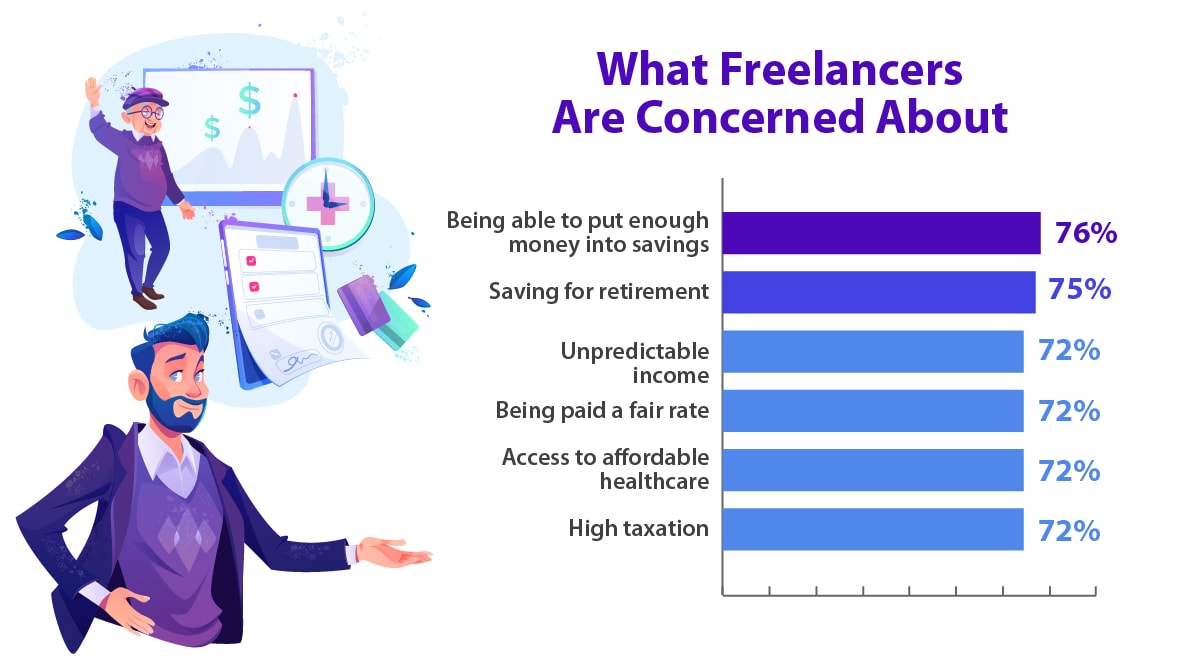
When respondents were asked what concerns them most about going freelance, their top answers were fairly evenly spread.
The ability to save money was the biggest worry for 76% of freelancers, closely followed by saving for retirement and an unpredictable income (75% and 72% respectively). Other common problems include being paid a fair rate, access to affordable healthcare, and high taxation rates.
It’s important to note many of these concerns will be shared by full-time employees as well. There are only a few (such as an unpredictable income) that would solely affect freelancers.
12. Freelancers Skew Young
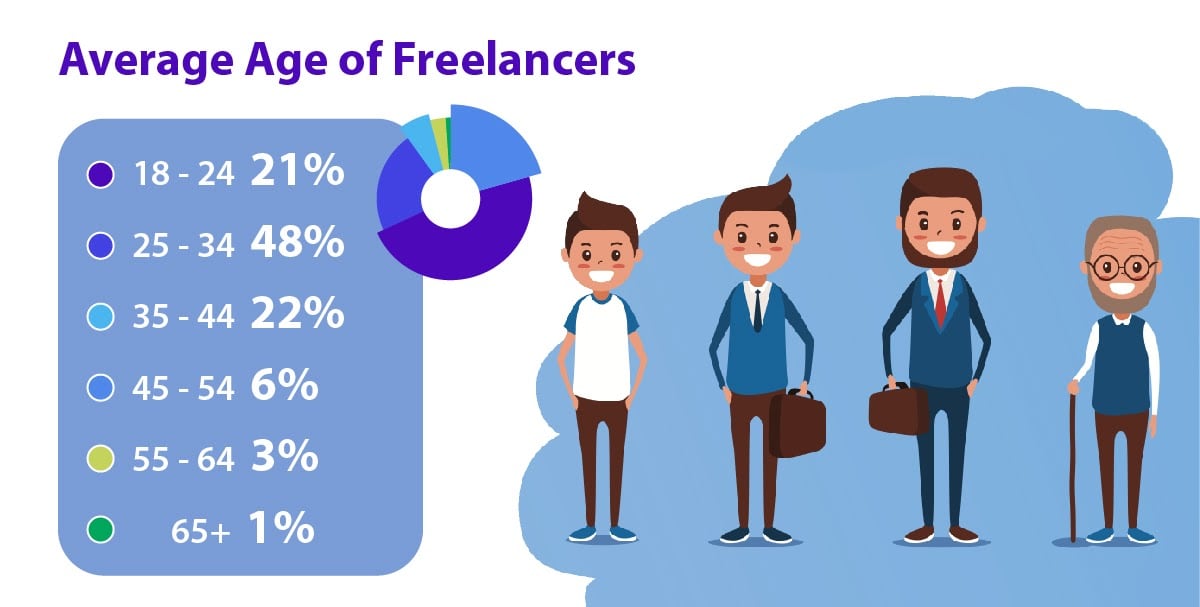 The majority of freelancers are heavily skewed toward younger ages, with almost 70% between the ages of 18-34 and only 10% over 45 years old.
The majority of freelancers are heavily skewed toward younger ages, with almost 70% between the ages of 18-34 and only 10% over 45 years old.
Freelancers often rely on new technology to successfully work remotely, which may appeal to a younger demographic. Younger workers are also less likely to have established professional and personal lives than older employees and may desire more flexibility when it comes to their jobs.
While younger workers are still the majority, we see the tide turning more generally in attitudes toward employment. Fewer people stay at the same company for long periods of time, and companies are turning to freelancers to fill in the gaps.
13. Freelance Gender Demographics
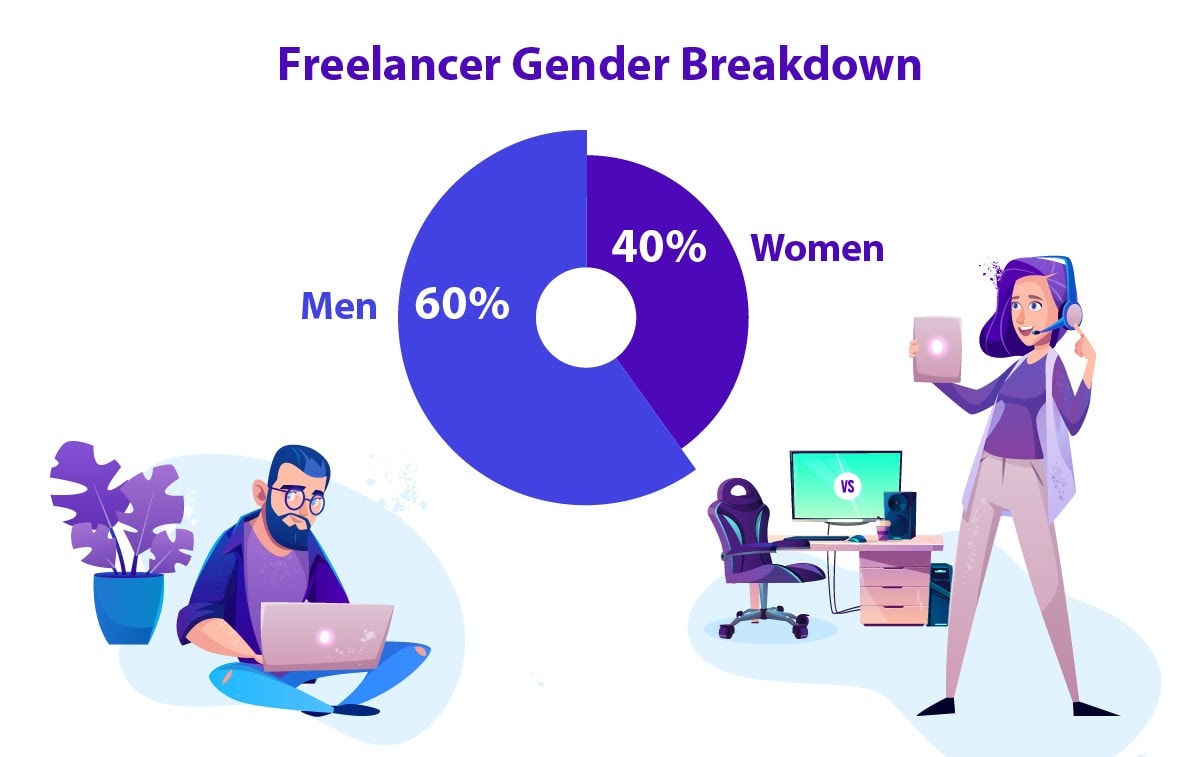
In the United States, 60% of freelancers identify as men and 40% women. This is more equal than the global average, where 77% of freelancers are men and 23% women.
14. Most Freelancers Work From Home
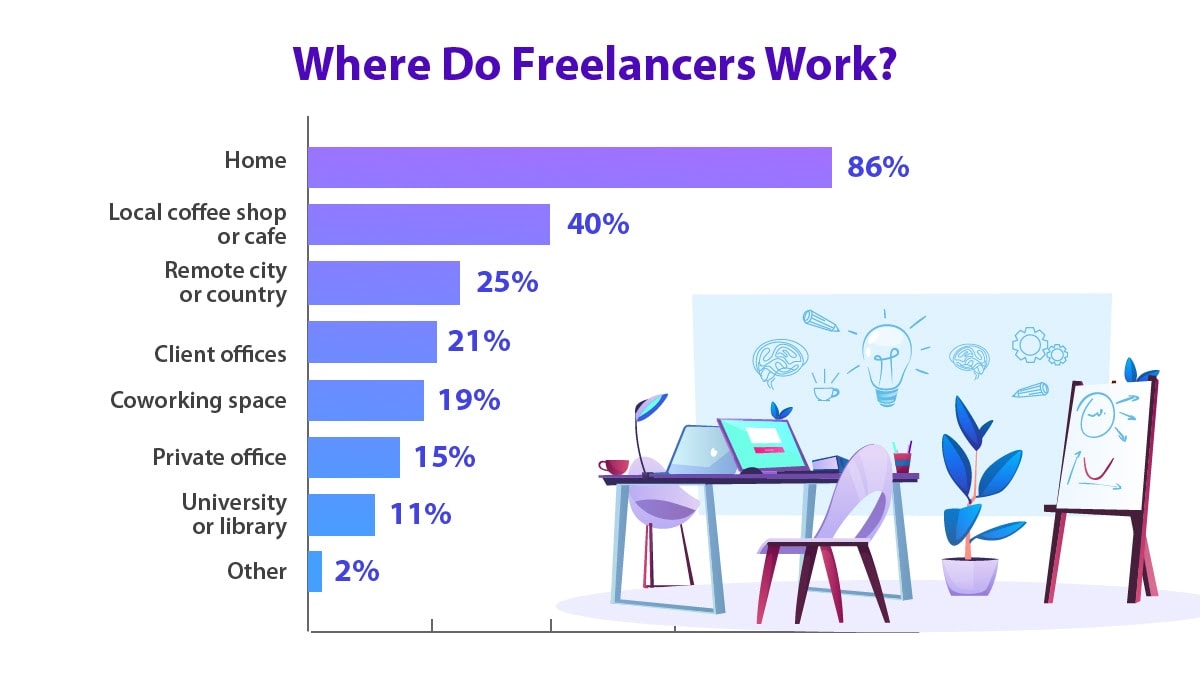 A recent survey revealed 86% of freelancers work from home during the week. Coffee shops are also popular, with 40% of respondents saying they typically spend some time working in cafes.
A recent survey revealed 86% of freelancers work from home during the week. Coffee shops are also popular, with 40% of respondents saying they typically spend some time working in cafes.
With the rise of digital nomads and the technology that makes this lifestyle possible, 25% of freelancers say they work remotely in another country or city. This ability to work from anywhere is a major draw for many freelancers.
15. Reasons People Choose to Freelance

People were asked about their top reasons for choosing life as a freelancer. The majority (79%) of full-time freelancers said it was so they could have more flexibility in their schedule, while 77% said it was to become their own boss.
For part-time freelancers, the most popular reason (75%) was to earn extra money. While financial reasons appear to drive part-time freelancers, full-timers seem more focused on improving their work-life balance.
16. Freelancers Juggle Multiple Projects
- The number of projects freelancers manage at once:
- One: 13%
- Two to four: 70%
- Five to nine: 13%
- 10 or more: 4%
The majority of freelancers have multiple projects going at any single moment – only 13% rely on a single project. A diversified client portfolio points to higher job security and the largest percentage of freelancers (70%) work on between two and four projects at the same time.
17. Half of Freelancers Are Intermittent Workers
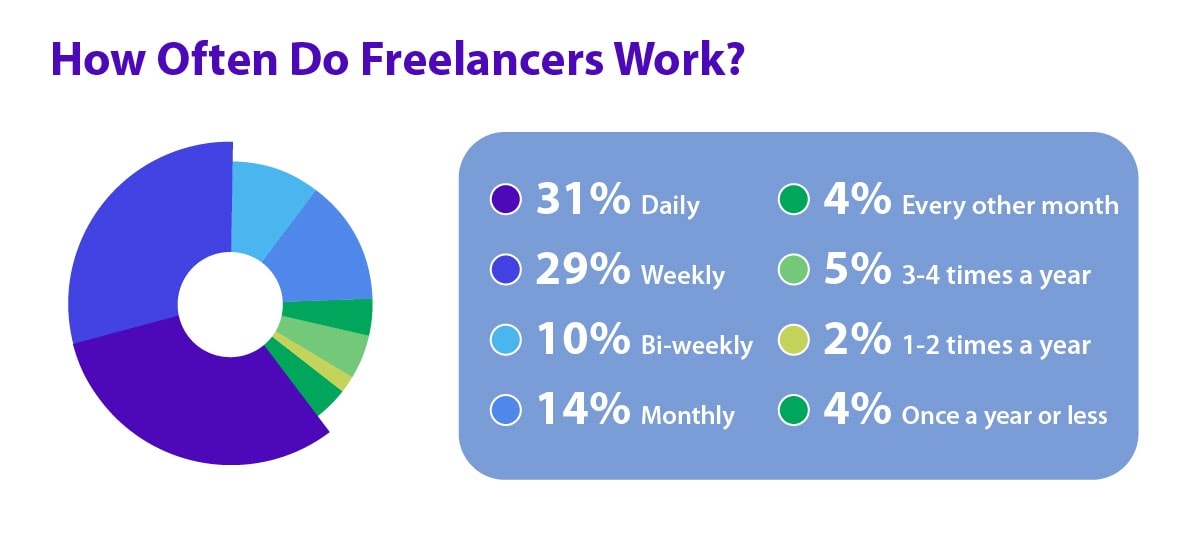
Around 40% of all freelancers work less than once a week, and likely have other, more traditional income sources in addition to their freelancing.
The majority are more consistent, with 31% working daily and 29% weekly, suggesting the ability to get regular work regardless of whether or not it’s their only source of income.
18. Education Freelancers Value the Most
- Degrees freelancers hold, globally:
- Bachelor’s or certificate degree: 54%
- Master’s or Ph.D.: 25%
- No degree: 20%
Freelancers tend to value skill training over formal education, with 93% claiming skill training was useful, while only 79% said their college education was still useful for what they’re currently doing.
In the last six months, 70% of full-time freelancers took part in some form of skill training, and only 49% of full-time traditional workers did the same. This shows freelancers are more regularly updating their skills in order to remain relevant in their trade.
Most freelancers are enhancing their skills in networking, technology, and business management. One barrier they face when accessing quality training is cost, which affects 53% of freelancers.
19. Freelancers Are More Politically Active
Freelancers, in general, tend to be more politically active than non-freelancers: 51% of full-time freelancers participate in political activities, compared to only 33% of full-time traditional employees.
72% of freelancers said they’d be willing to cross party lines to vote for a candidate that supports freelancer interests. This indicates how strongly freelancers feel and suggests they would be more vocal around these issues.
20. Most Freelancers Have Multiple Skills
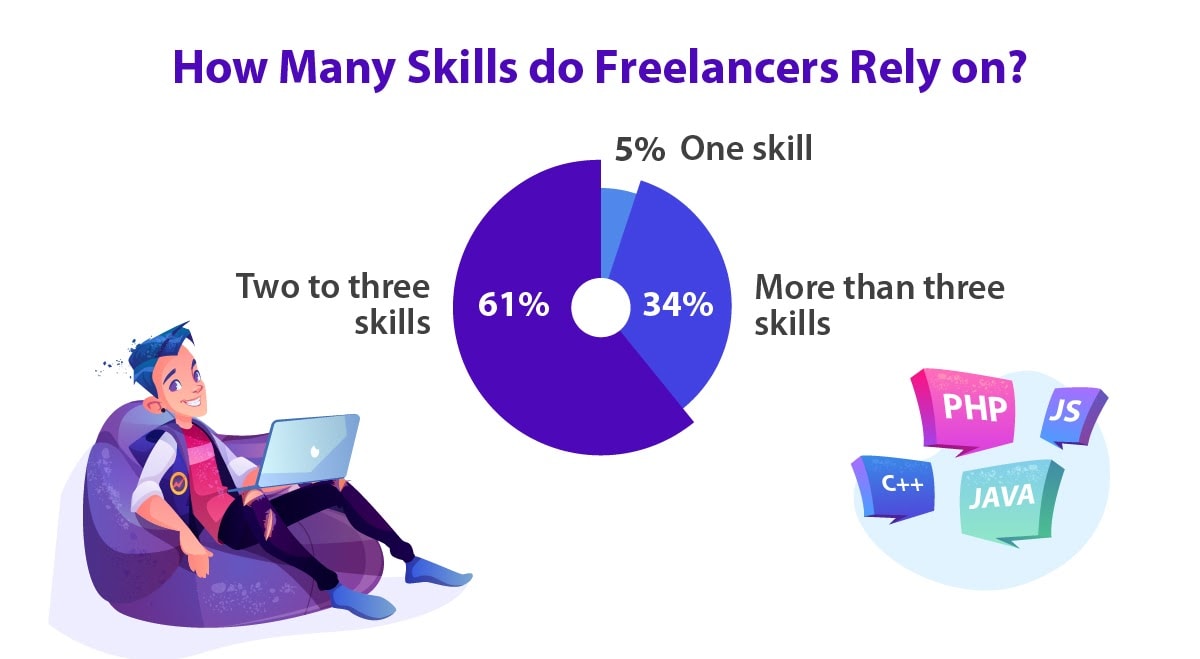
In a recent survey, 61% of freelancers claimed they use two to three skills in their weekly work activities, while 34% rely on more than three. Only 5% are dependent on a single skillset.
This shows that freelancers have effectively diversified their skillsets for job opportunities across a range of project types.
Benefits of the Freelance Economy
Now we’ll take a look at statistics that illustrate the far-reaching benefits of this rapidly growing economy.
21. Freelancers Contribute to the Economy
- Freelancers contributed $1.2 trillion to the U.S. economy in 2020
- Freelancing makes up 5.7% of GDP in the U.S.
With low barriers to entry and the ability to work as much or as little as you’d like, it’s no surprise that freelancing is an attractive proposition for many workers.
22. Freelancers Have a Better Work-Life Balance
According to an Upwork study, 77% of full-time freelancers believe they have a better work-life balance since going independent. However, this does come at a cost, as 63% also claimed to feel anxious about new responsibilities they have to manage.
More than two-thirds (77%) said they now have more time for the people and things they care about. A similar number of freelancers (76%) claim that their freelance work is more stimulating, which is probably why 51% claim that no amount of money could get them to return to a traditional position.
23. Freelancers Are Happier, Healthier
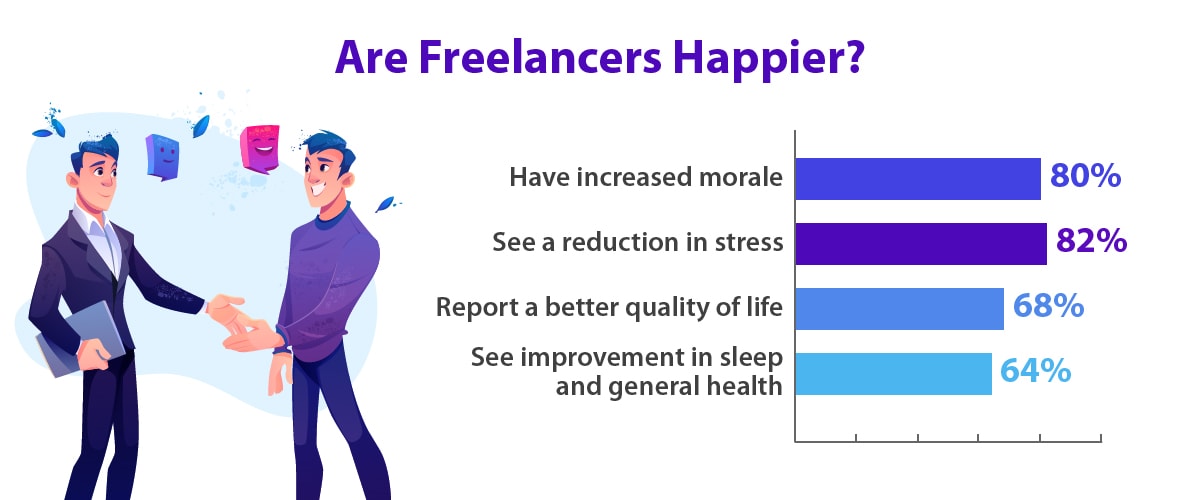
According to a recent study, 80% of freelancers reported an increase in morale, while 82% said their stress levels had decreased.
In another study, 68% claimed their quality of life had improved since they began freelancing, while 23% said it’s about the same. Only 9% said it had worsened.
It’s not surprising, then, that many respondents reported experiencing health benefits since going freelance—nearly two-thirds saw an improvement in their sleep and overall health.
24. Freelancers Are More Optimistic About Advancement Opportunities
Feelings regarding career advancement potential (freelancers vs non-freelancers):
- My position provides the opportunity for upward mobility
- 72% of freelancers agree
- 53% of non-freelancers agree
- My job provides pay appropriate to my skill level
- 77% of freelancers agree
- 62% of non-freelancers agree
- My work is challenging, giving me the opportunity to develop new skills
- 81% of freelancers agree
- 67% of non-freelancers agree
- My job offers a long-term career path
- 77% of freelancers agree
- 69% of non-freelancers agree
A recent questionnaire asked freelancers and those holding traditional positions, about their career prospects. When asked if they thought their position offered upward mobility, far more freelancers felt there was opportunity to move up when compared to their traditionally-employed counterparts.
Freelancers were generally happier with their jobs’ rate of pay, skill level, and long-term career paths. This may be because freelancers feel they have more control over their work and can negotiate rates on a project-by-project basis.
25. Many Freelancers Feel More Secure in Their Employment
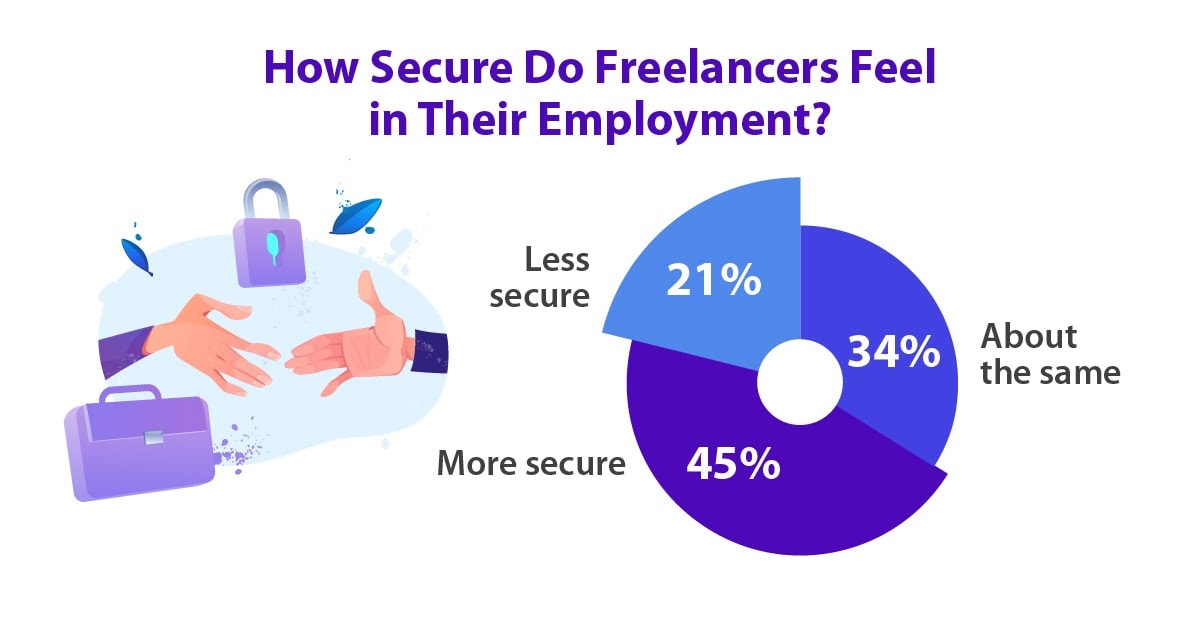
Compared with recent years, 45% of freelancers say they now feel more secure about their employment. This could be because they’ve had more experience freelancing, or because there are more opportunities available. Only 21% said they feel less secure, and 34% said they feel about the same.
In the same study, 41% of respondents said they intend to freelance for the foreseeable future. The majority (63%) also believe having a diversified portfolio of clients gives them more security than just one employer (up by 10% since 2016). Most freelancers average 4.5 clients per month.
26. Freelancing Supports a Variety of Personal Circumstances
In a recent survey, 42% of respondents said freelancing has given them the ability to work when they were unable to hold a traditional position due to personal circumstances.
This allows those with children, health problems, special needs, or other personal commitments to comfortably work from home, when other options may not be available.
Income in the Freelance Economy
Freelancing can be incredibly lucrative for some, while others barely scrape by. This depends on a number of factors, so knowing the statistics behind incomes is useful for those considering going freelance, as well as for those hiring.
27. On Average, Women Earn Less Than Men
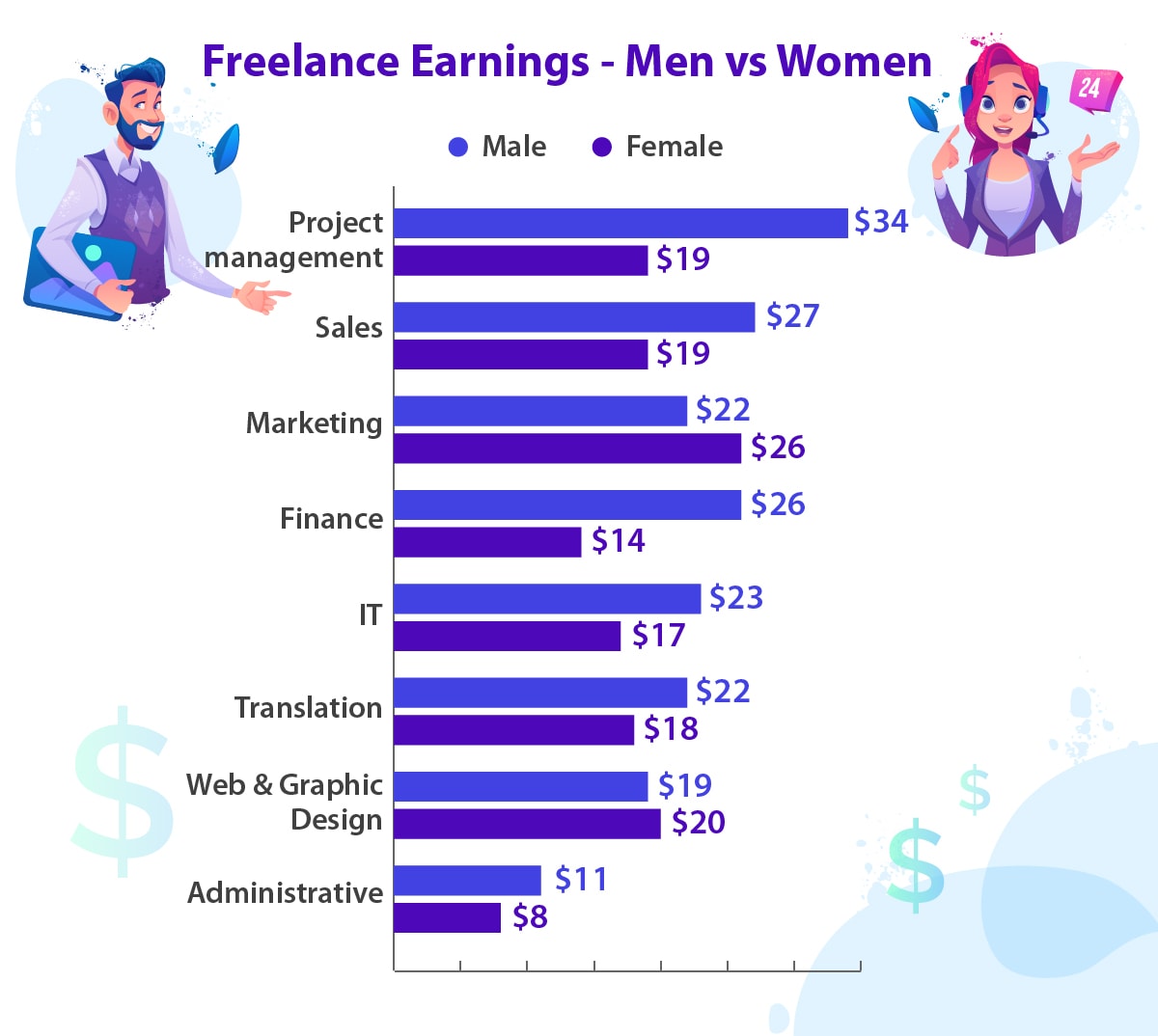
Globally, women in traditional jobs make only 54% of the amount men make. While this disparity still exists in freelancing, it’s smaller, with women earning 88% of their male counterparts’ income. In our own research on freelance platforms, we found the gender gap to be greater.
The discrepancy varies by industry. It’s most pronounced in the IT and programming fields, where women’s hourly rates average 74% of men’s. However in some industries, like design and multimedia, women earn more than men.
There are exceptions to this general trend. In countries like Romania, Mexico, and Venezuela, there doesn’t appear to be a freelance gender pay gap, and in Bolivia and Indonesia, women actually earn more than men.
28. Average Freelance Earnings per Hour by Industry

When analyzed by industry, project managers demand the highest pay, earning $28 per hour on average. Administrators are paid the least, with freelancers earning $10 per hour on average.
Generally, the industries that pay more require specific skills or experience. For this reason, there tend to be fewer freelancers who can offer these services, allowing those who do to charge higher rates.
29. Average Global Freelancer Earnings per Hour
When it comes to pay per hour, here’s what freelancers are earning around the globe:
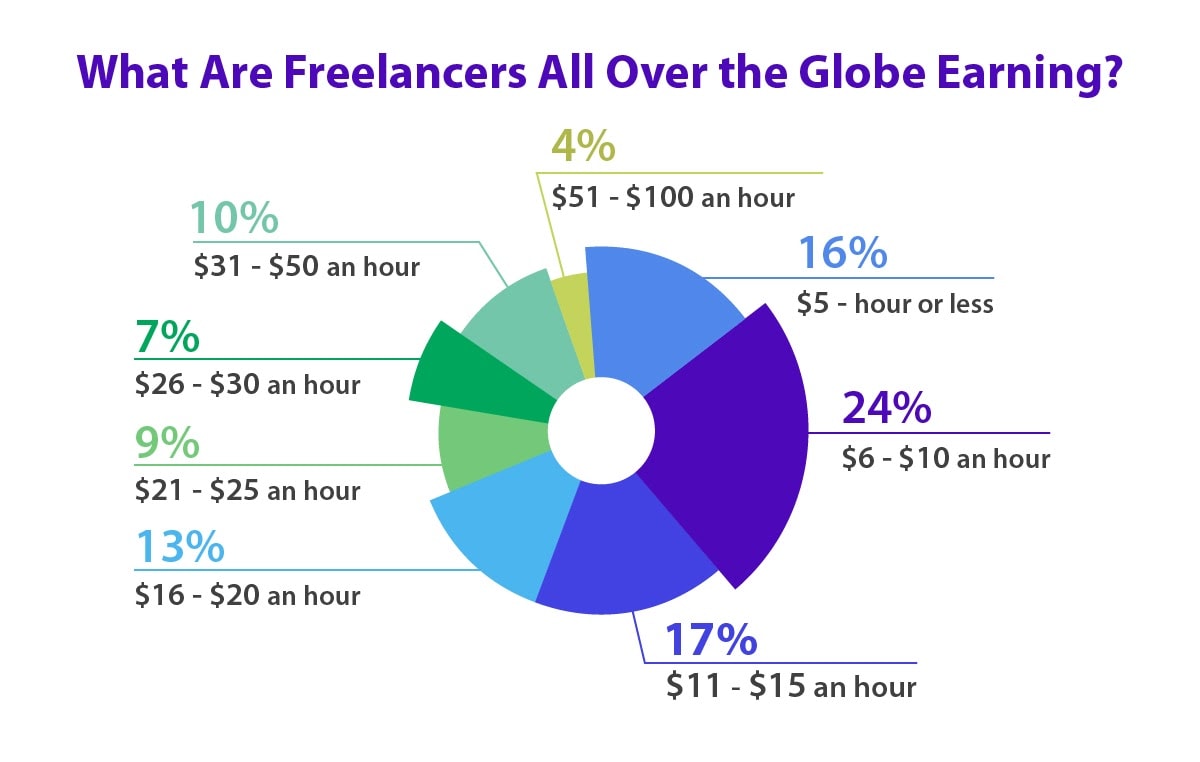
Across 170 countries, the average hourly rate for freelancers was $19
When analyzed by hourly rate, the majority of global freelancers (57%) make less than $15 per hour, and only 14% make more than $30 per hour.
While this may seem a bit grim, these rates vary wildly depending on a number of factors, such as home country, native language, area of expertise, and experience level. Those with the right skills and experience are likely to make well over the global average of around $19 per hour.
30. When It Comes to Pay, Experience Trumps Education
Degrees don’t matter too much when it comes to the average hourly rate:
- High-school education: $22 an hour
- Certificate, or bachelor’s degree: $19 an hour
- Master’s degree or Ph.D.: $24 an hour
With freelancers, clients pay far closer attention to experience and ratings from past clients than they do education. This was determined by analyzing the average hourly rate of freelancers based on their level of education.
Those who are older and have more life (and career) experience, as well as those who have earned positive feedback on a freelance platform, tend to enjoy higher pay rates.
31. Full-Time Freelancers Struggle With Managing Debt
- Feel like they live paycheck to paycheck
- 59% of freelancers
- 53% of non-freelancers
- Have college loans or other debts to pay off
- 46% of freelancers
- 36% of non-freelancers
When freelancers were asked how they handle their outgoings, 59% said they feel like they live paycheck to paycheck, compared to 53% of full-time, traditionally employed workers.
Compared to traditional workers, 10% more freelancers have college loans or similar debts, with 46% reporting they have yet to settle those debts.
However, freelancers are better equipped for emergencies, with 52% saying they have enough money to cover emergencies, and 43% have enough money to go without two weeks of pay; this compares to 44% and 31% respectively for their full-time employed counterparts.
32. Freelancers Get Ripped Off … A Lot
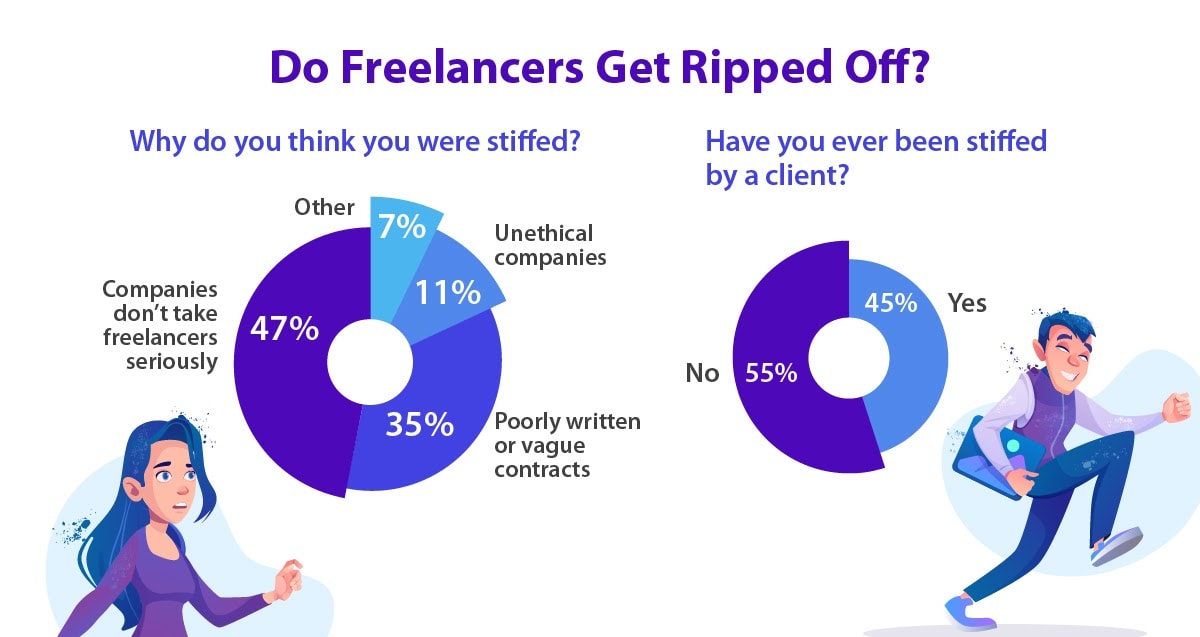
One unfortunate aspect of freelancing is unreliable clients. When asked if they’ve ever been stiffed by a client, a shocking 45% of freelancers admitted they had, while 55% had not.
Most workers believe this is due to a lack of respect for the freelancer community, and 35% blame vague or poorly constructed contracts.
This is a big advantage to working on freelance platforms like Upwork or Freelancer.com, which have systems in place to ensure contracts are upheld and offer arbitration services when needed.
Future Projections
According to most experts, the future of freelancing looks bright. Here are some of the top projections to what lies ahead for this rapidly expanding economy.
33. Freelancers Will Make Up Majority of U.S. Workforce
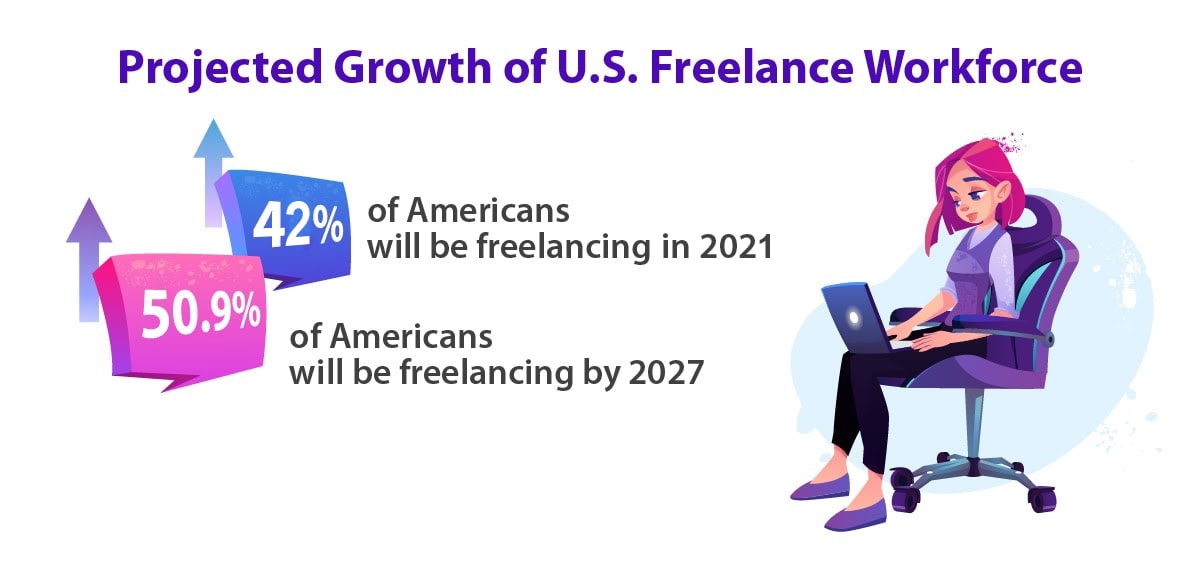
By the year 2027, freelancers are projected to make up the majority of the workforce in the United States, with 50.9% of the working population.
In fact, at the current growth rate, it’s estimated that 67.6 million Americans will be freelancing by the end of 2021. That’s 42% of the American workforce! This will have significant implications on how businesses are operated and how projects are managed.
34. More Businesses Will Use Freelance Workers
Well, this just makes sense. If there are more freelance workers, then there will be more businesses utilizing their services. By the end of 2021, it is projected that 56% of companies will allow global remote work, with 16% of companies employing the entirety of their staff as global remote workers.
On average, permanent remote work will make up 34.4% of companies’ workforces. This means remote work will more than double compared to pre-pandemic figures, rising from 16.4%.
35. What Freelancers Want More of in the Future
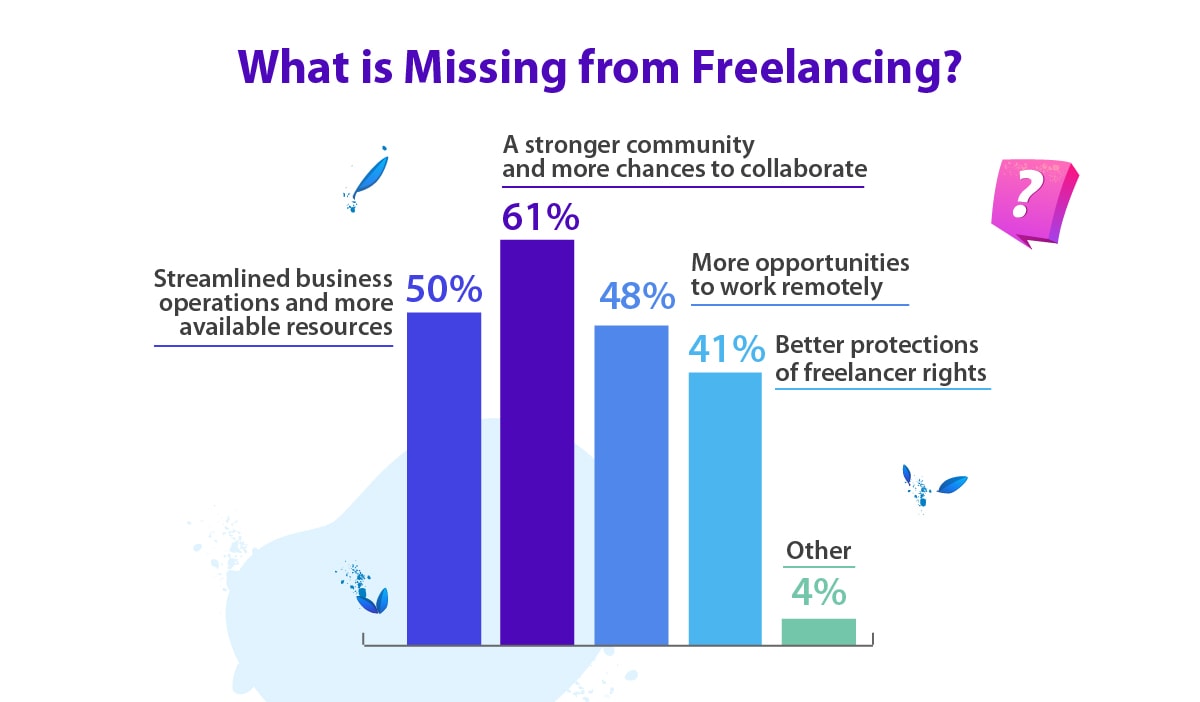
Freelancers were asked what they thought was missing from the world of freelancing that they’d like to see more of in the future. The majority, with 61%, feel that freelancing lacks a strong community, and could benefit from improved collaboration.
Respondents would also like more streamlined business operations, more remote work opportunities, and better protection of their rights.
It’s only a matter of time before these needs are answered by opportunistic companies, and a number of apps are already available to help freelancers and remote teams stay productive.
36. Globalization and Freelancing
Freelancers view globalization as:
- An opportunity for expansion: 71%
- A non-threat or net-neutral: 21%
- A threat due to increased competition: 8%
A recent study analyzed freelancers’ attitudes toward globalization. Most freelancers view globalization as a positive, with more potential clients and job opportunities. However, outlooks are likely to vary based on the freelancer’s skills and how competitive their industry is.
37. No Amount of Money Could Take Me Away From Freelancing

51% of freelancers say there’s no amount of money that could convince them to take a traditional job.
Nonetheless, 29% of freelancers affirm that they would be persuaded to transition into a permanent position if they could earn up to an additional $5,000 USD each year. For 4% of freelancers, the ideal scenario would involve a raise of over $100,000 in annual pay to contemplate the switch.
30 More Stats
- Roughly 1.1 billion freelancers are working around the world
- 7 out of every 10 freelancers prefer living away from the big city
- 35.5% of freelancers are located in Europe – more than any other continent
- There are 3.4 million freelancers in Japan, making up 5% of the country’s workforce
- There are more than 1.4 million freelancers working in the UK
- In the United States, the Freelance workforce is growing 3 times faster than the overall US workforce
- UK freelancers average 27 hours of work per week, which is significantly less than in the rest of Europe
- US freelancers earn the most, with year-on-year revenue growth of 78%
- Due to the coronavirus pandemic, freelance job postings grew by 41% in the second quarter of 2020
- Companies with at least 11% of freelancing staff earned, on average, $6,400 more than businesses that employed fewer freelancers
- Employers save $11.6 an hour per employee by hiring freelancers
- Upwork earned $87.5 million in the last quarter
- On average, freelancers in the US earn more than 70% of professionals
- In the United States, 40% of freelancers are more educated than the average worker
- A contract is won every four seconds on Fiverr
- 73% of freelancers have not changed their rates due to coronavirus
- The entertainment industry hires the majority (55%) of its staff as freelancers
- There are over 1,800 different categories of jobs on Freelancer.com
- 1.07 billion hours are spent freelancing each week, averaging out to 19 hours per freelancer
- People who work from home are, on average, 13% more productive than those who do not
- There are 4.1 million digital nomads (people who fund their travel through freelancing)
- Of all the companies actively hiring freelancers, only 1 in 4 would consider a freelancer for an HR role
- 57% of full-time freelancers find their work interesting
- 17 million people desire to be a digital nomad
- Freelancers make up 75% of staff employed in the arts and design industry
- 96% of freelancers believe freelancing has changed in recent years
- 90% of digital nomads are satisfied with their work
- 30% of all remote work companies have a female CEO or founder
- Remote workers save between $2,000 and $7,000 a year, compared to office workers
- There are 10.9 million digital nomads in America, 49% more than in 2019
The Takeaway
Freelancing is quickly evolving to become one of the primary sources of income for people across the globe. So whether you’re a client in need of good help, or a worker looking for an extra revenue stream, this more flexible way of working offers a tremendous opportunity to countless industries.
Sources:
Statista
Payoneer
Upwork
Edelmann
Freelancers Union
US Department of Commerce
Vectorpunch/freepik.com
OwlLab
Enterprise Technology Research
MBO Partners, State of Independence Report







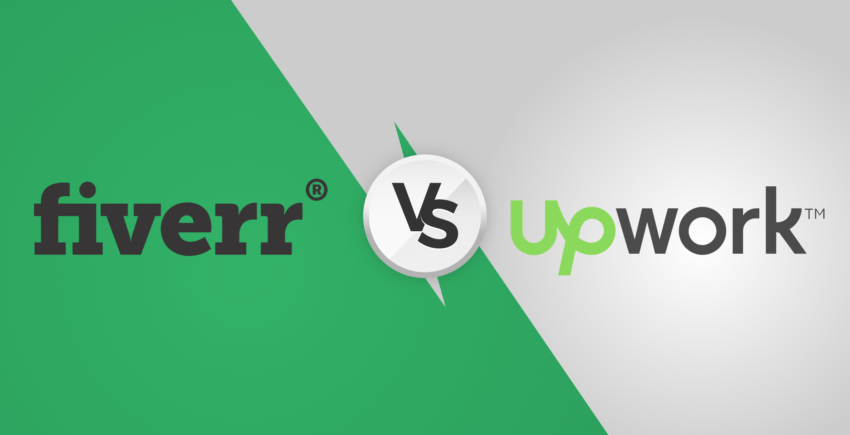



![Ultimate Guide to Being a Freelancer [2026 Update]](https://dt2sdf0db8zob.cloudfront.net/wp-content/uploads/2018/11/chapter-840x430.png)
![How to Price Your Freelance Work [2026 Guide]](https://dt2sdf0db8zob.cloudfront.net/wp-content/uploads/2018/11/chapter3-840x430.png)
![How to Create a Winning Freelance Profile [Full 2026 Guide]](https://dt2sdf0db8zob.cloudfront.net/wp-content/uploads/2018/11/chapter2-840x430.png)





